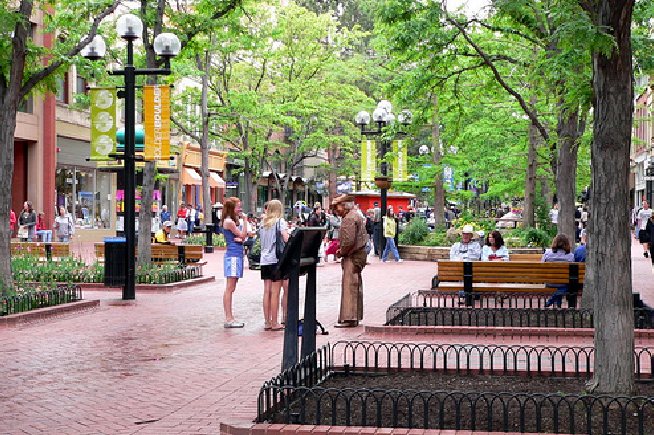BY ALEX BACA AT THE AMERICAN CONSERVATIVE
Last year, Boulder, Colo., considered referendums that would have, in short, made it difficult to ever expand the size of the city, currently home to just over 100,000. It was a classic example of some residents, despite largely liberal political preferences, trying to keep out newcomers—and stop any resulting increase in density.
Earlier this year, Better Boulder, a collective that had mobilized opposition to the anti-growth initiatives, invited to town some 150 people who, had they lived there, would also have voted against the referendums. For three days, Boulder was YIMBYTown, a new conference named for “yes in my backyard,” a retort to emotional, parochial, and self-serving “not in my backyard” traditions in community planning.
I came to YIMBY skeptical and ready to judge. The attendees were largely coastal and clustered in San Francisco, Seattle, Portland, and Austin—former slacker towns where housing costs and new residents are increasing, but housing stock is not. Boulder, where I attended college for one year as an urban planning student, is a jewel of a place framed by the Flatiron mountains, but it’s wealthy and tremendously (88 percent) white; and YIMBY’s racial demographics reflected that. And while I was pleasantly surprised by the diversity in age and gender, it was obvious that nearly everyone was fluent in technology, Twitter, and testifying at public meetings.
Thus if not inclusive, the crowd was interesting: The YIMBY movement isn’t highlighting new concepts, necessarily, but is attractive to techno-libertarians who have found themselves disadvantaged by rising rents in a way that an American Planning Association conference is not. As such, the YIMBY attendance list was heavy on organizers, nonprofit staffers, and land-use enthusiasts, but light on public-sector workers and elected officials.
To fund the conference, organizers relied on ticket sales and a grant from the National Association of Realtors; a grant from Open Philanthropy largely supported scholarships. (I received one, which covered my travel costs.)
Sonja Trauss, whose Bay Area Renters Federation has embraced the YIMBY label from its get-go, delivered the opening keynote. BARF emerged in 2015 and got its most significant screen time opposing a moratorium on anything but 100 percent affordable developments in San Francisco’s Mission neighborhood. That initiative was defeated (as a San Francisco resident at the time, I voted against it), but the same scene is playing out in the nation’s other high-demand cities.
A neighborhood, usually dense with amenities, walkable, and anchored by transit, becomes favored by newcomers, who have arrived because that region has jobs for the taking. The newcomers, usually relatively flush with cash, are more favorable tenants than working-class and low-income families. Longtime residents squall in protest to any sort of new housing, either to protect their property or personal values. Nothing gets built, and the neighborhood becomes steeply unaffordable to anyone but those who had the good fortune and foresight to buy their homes decades ago.
Trauss, a former teacher who grew up with an “anti-suburban” bias in Philly, spoke convincingly of running movements like BARF as “do-ocracies,” where anyone with an idea is tasked with putting that idea into place, and of diversifying neighborhoods. “We need to be integrationists,” she told the crowd, which was busily tweeting out her declaratives. “We can’t count on liberals, or even ourselves, to want to live in integrated communities.”
For me, the conference was a welcome opportunity to meet other people who weren’t befuddled or outright angered by the idea of building more housing to keep cities affordable. By Friday afternoon, I had donned a green YIMBY trucker hat and stuck up a Post-It note with a session pitch. (My topic? “What We Talk About When We Talk About Gentrification,” based around the idea that there is no consistent definition of gentrification, which makes it hard to discuss and harder to contain.)
Other sessions shared lessons learned from Austin’s loosening of regulations on accessory dwelling units, building more equity and diversity into the fledgling YIMBY movement, and how to communicate campaigns advocating for the construction of more housing.
YIMBY’s tenets are not necessarily intuitive to the regular citizen. While researchshows that the way to keep in-demand neighborhoods affordable is to increase supply, many people aren’t comfortable acknowledging that housing works just like many other markets. And as Trauss noted, even the most accepting among us may recoil at doing what it takes to truly integrate neighborhoods, a process that happens at the expense of our own families. But If there’s evidence of YIMBY ideas solidifying into policy, it’s Seattle’s Housing Affordability and Livability Agenda. While by no means a panacea, HALA will give Seattle a shot at maintaining the neighborhoods its residents have tried to protect, while building more, similar places to meet demand.
So, whither the YIMBY movement? As other dispatches have noted, YIMBY must build a bigger tent—demographically, ideologically, and geographically. And its adherents will need to make the transition from chattering on Twitter to chattering in real life—not just at meetings concerning pet issues, but whenever the opportunity arises. Still, YIMBY is positioned to bring to the general public the ideals long pushed by groups like Smart Growth America, the Congress for New Urbanism, and Strong Towns, all of which promote walkable places designed for people.
Those ideas don’t fall along a specific political axis, despite Trauss addressing her comments to liberal city-dwellers. Giving Americans more choices in where to live, whether by relaxing regulations, building more housing, incentivizing sensible land use, or connecting more places with frequent, efficient transportation, is neither conservative nor liberal. It’s just a common-sense corrective. After all, the suburbs are subsidized. So are highways. We’ve essentially outlawed building places like those we profess to love.
A YIMBY conference will happen again if another city can organize it. There’s no funding committed to its continued existence, and its attendees are not dues-paying members. YIMBY values, though, are poised to permeate the housing-crisis conversation, which is reaching a fever pitch as more Americans realize that the places where jobs exist are the most expensive.
If YIMBY speaks loudly enough, it could turn the tide of the way that we think about urban growth, which has, for a long time, prioritized the individual over community. “We’re just talking,” Trauss told me. “I used to think that wasn’t much. But now I think that it’s a good thing.”
Alex Baca lives in Cleveland, Ohio, and has written for Washington City Paper,CityLab, and Slate. “New Urbs” is supported by a grant from the Richard H. Driehaus Foundation.

